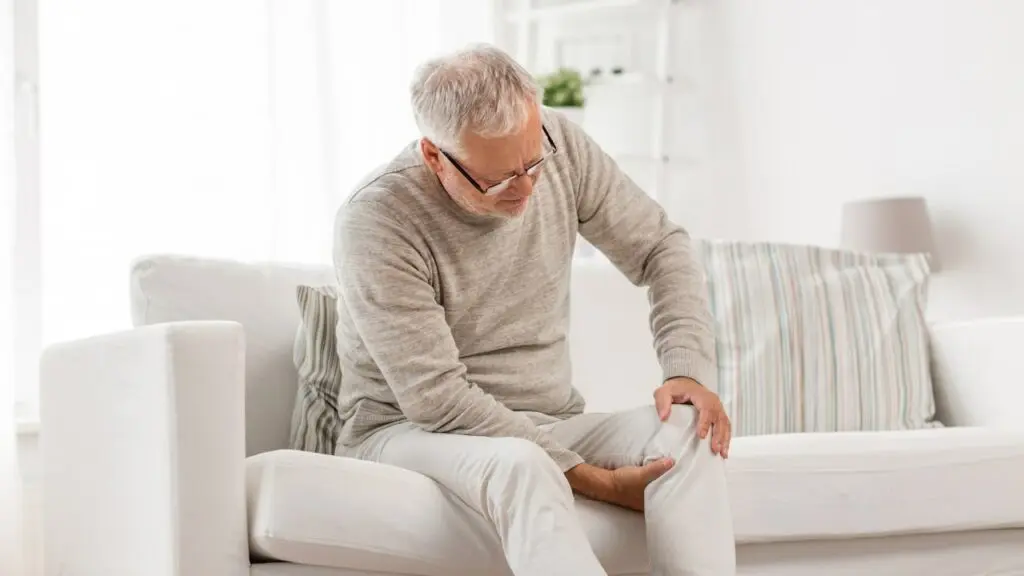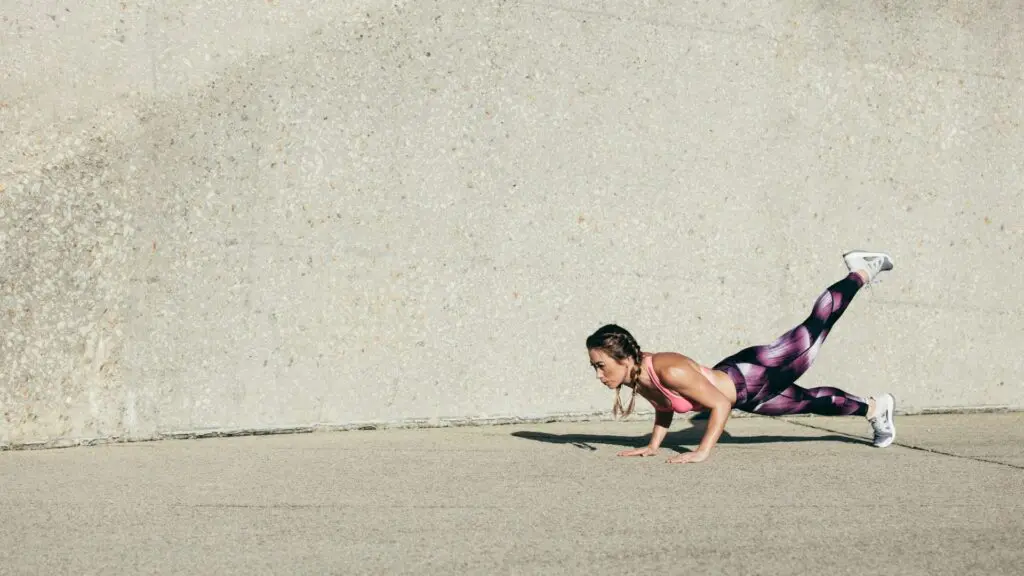
Strengthen Weak Knees If You Have Back Pain With 3 Simple Exercises
If your knees are not strong you will have a real struggle recovering from lower back pain. This is because the muscles that keep your knees healthy also help protect your lower back. Finding a safe way to strengthen your knees if you have lower back pain is going to be the key to unlock healthier knees and a pain free lower back too. Today we will cover three exercises everyone can do to help strengthen their knees at home, starting from the very simple with support, building up to a more challenging option that can help you build strength in your knees and back for the long term.
Exercise one: elevated step down for knee strength
This first exercise is an easy knee strengthening exercise that anyone can do at home, you just need a small platform or step to begin with. It engages your hip muscles which help control your knee, and then you use the muscles of your thigh to slowly lower yourself. For those of you with weak or painful knees, you will want to start out near a support, be it a chair or counter, so you feel safe when doing the exercise. Remember this should not be painful so go as low as you feel comfortable.
How to do the step down exercise for your knee health
- Start standing on a step or platform with one foot on the edge.
- Engage your core and back muscles to hold your spine protected
- Using support if needed hinge at the hip joint to engage your hips
- Slowly bend the knee to lower your other leg held straight
- Stop when you feel you’ve gone as far as you can
- Keep your knee stable with no movement left or right as you bend.
- Repeat for 10 reps and then swap legs.
This exercise can be done for 10 reps with three sets done in a row, swapping from one leg to the other and back again. To make this exercise harder there are two things we can do. Firstly you can increase the height of the platform so you have room to go lower, secondarily, you can add weight or resistance bands to make the exercise more challenging on the muscles. A combination of both, over time is the best way to progress. Remember you should use a range of motion that you feel is comfortable, pain-free, but challenging on the muscles – not the joints.
Exercise two: planted static lunge
This exercise is one that requires nothing other than a support if your balance is not good in the beginning. This could be considered a step up from the previous exercise as there is more movement taking place and so your balance will be a factor here, which is great as our ability to balance is vital as we age. The challenge will help you develop this skill over time. This planted lunge starts out focussing on the front leg which is the working leg, we then slowly lower ourselves as we engage the muscles of the hips, core, back and thigh, to execute the movement. Our back leg is merely there for support but most of your focus should be on the front leg.
How to do the planted static lunge
- Start out in a split stance with your front leg the focus
- Using support if necessary engage your core and back muscles
- Slowly bend the front knee to move into the lunge position
- Go as low as you feel comfortable, with support if necessary
- Then push through your front leg, back up to the starting position
- Repeat for 10 reps and then swap legs
This exercise can be done for 10 reps with three sets done in a row, swapping from one leg to the other and back again. This exercise can be made easier elevating the front leg on a platform with support to help you if your knees are particularly weak. Over time you can eliminate the use of the supports and elevation and add in weights. More advanced variations of this exercise can be done using elevations commonly referred to as the ATG split squat, used by people of all ages, carefully, to improve their knee health. This method is something I’ve personally used to help improve my knee health after a minor injury and has been used to improve the resilience of my knees in a very positive manner.
Exercise three: elevated split squat
This final exercise is the one that can be used to build real strength in your knees for the long term. Because you are a little more stable the movement can be used to build strength more effectively in our experience. This can be done in the living room or bedroom with your back leg elevated on the sofa or bed. The front leg is lunged forwards for the starting position. Then you simply lower yourself into the “lunge position”. This exercise allows you to again control and support yourself effectively, starting out with support if need be, then adding weights over time as well as going lower to challenge the muscles that stabilise your knees and support good back health. You will find this exercise the easiest to increase the weights with.
How to do the elevated split squat
- Sit down with your front leg outstretched straight to get your start position
- Then stand up where your front foot was placed
- Elevate the back leg to rest the front of your ankle on the chair
- Engage the core and back muscles for stability
- Slowly bend the front knee to lower yourself as far as comfortable
- Then return to the starting position.
This exercise can be done for 10 reps with three sets done in a row, swapping from one leg to the other and back again. You can experiment with shorter or longer stride positions and you will feel the focus of force change from your hips to your thighs accordingly, this can be used to work on areas of the hips in a more targeted manner. When using weights for this exercise, you can also experiment with the side you hold a weight on, holding the weight on one side (the same as the front leg) will often make it easier to use heavier weights for power. The opposite setup generally offers you an ability to work a deeper rep in a more efficient way.
Biggest mistake when strengthening your knees & back
These exercises offer a great way for you to build strength in your hips and knees, but common errors will set you back and are to be avoided to ensure you have a safe experience of strengthening these muscles to keep the knees and back healthy.
Avoid pain when doing these exercises
For some with particularly bad knees or lower back, doing these exercises could cause pain. So long as you do not go further than you are competent to go, you will experience no pain. This might mean that you are performing very little movement to begin with. Your goal is to do the hardest version of the movement that does not cause you pain, or more than a 1-2/10 level of pain specifically.
When you get pain, it is usually because you’ve gone too low and you are no longer controlling the movement. If it is knee pain, your knees are failing to keep composed. If it is back pain, you’ve probably forgotten about good posture, back and core muscle engagement. If you need help engaging your core, then check out the core activation drill for back pain we recently recorded.
Why these exercises are great for your knees and back health
There are a couple of reasons why these exercises are great if you have knee or back issues. Firstly, you can do them anywhere, at home or in the gym. So they’re accessible. Secondly, no matter how bad you are, in the knees or the back, you can do some variation of these exercises. Sore knees or back, fine, use support or don’t go as low. Thirdly, you can scale them to build strength, if you’re finding them too easy, go lower, add weight, make them harder in these ways to make your knees and back stronger. Fourth, they are very efficient, for time. You can simply do 10 reps on one leg then 10 on the other, and repeat. Sometimes people find it awkward adding their own rest, doing nothing whilst they’re “recovering”. In this case, whilst you might find you want to give yourself a moment before returning to the first leg, the rest is whilst the other leg is working – very simple. Finally, your knees and back are closely related via the hips. Part of the reason people have back issues is because their knees are not healthy or strong, improving the health of the knees means the back is more protected.
You often do not realise your knees are quite so unhealthy until you injure your lower back. Then the reality hits you that you hardly ever bend your knees, your lower back is constantly bending and rounding. It should not be this way, but many of us in the west have developed these issues that mean when our back does become injured, say from a lumbar disc bulge or herniation, we have a real issue recovering.
Final thoughts to help you fix your knee and lower back health
There’s never a better time to improve your knee health than when you do not have pain in either the back or the knee, but most will not be this fortunate. So when you are forced to improve your knee health for the sake of your lower back, take time, use these simple exercises and focus on good, pain free motion to begin with, and build from there. With time you will make tremendous strides of improvement and your lower back will be all the better for it. If you need any more help with your back pain specifically, then check out the free masterclass for fixing lower back pain, and if you want a little more support and guidance, the membership to the Back In Shape Program.









Responses